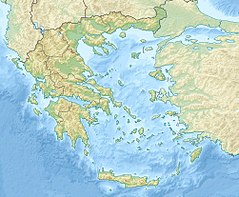
Back المرصد الوطنى لاثينا ARZ Nationales Observatorium Athen German Εθνικό Αστεροσκοπείο Αθηνών Greek Observatorio Nacional de Atenas Spanish Ateenan kansallinen observatorio Finnish Observatoire national d'Athènes French ಅಥೆನ್ಸ್ ರಾಷ್ಟ್ರೀಯ ವೀಕ್ಷಣಾಲಯ Kannada Nationalen Observatoire Athen LB Obserwatorium Narodowe w Atenach Polish Афинская национальная обсерватория Russian
 Logo of the National Observatory of Athens | |||||||||||||||||||||||||||||||
| Motto | Servare Intaminatum | ||||||||||||||||||||||||||||||
|---|---|---|---|---|---|---|---|---|---|---|---|---|---|---|---|---|---|---|---|---|---|---|---|---|---|---|---|---|---|---|---|
| Established | 1842 | ||||||||||||||||||||||||||||||
| Research type | Basic,Applied | ||||||||||||||||||||||||||||||
Field of research | |||||||||||||||||||||||||||||||
| Director | Manolis Plionis | ||||||||||||||||||||||||||||||
| Location | Athens, Greece 37°58′24.2″N 23°43′5.6″E / 37.973389°N 23.718222°E | ||||||||||||||||||||||||||||||
| Website | http://www.noa.gr | ||||||||||||||||||||||||||||||
| |||||||||||||||||||||||||||||||
The National Observatory of Athens (NOA; Greek: Εθνικό Αστεροσκοπείο Αθηνών) is a research institute in Athens, Greece. Founded in 1842, it is the oldest research foundation in Greece. The Observatory was the first scientific research institute built after Greece became independent in 1829, and one of the oldest research institutes in Southern Europe. It was built around the same period as the United States Naval Observatory.[1][2]
World-renowned Greek-Austrian astronomer Georgios Konstantinos Vouris lobbied to create the National Observatory of Athens in the newly founded state. He persuaded wealthy Greek-Austrian banker Georgios Sinas to pay for the new massive observatory. The Austrian-born Greek King found out the news and awarded Georgios Sinas's son the Order of the Redeemer. The King also selected the architects for the building under Georgios Konstantinos Vouris's supervision. He chose Eduard Schaubert and Theophil Hansen.[3][4][5]
The Athens observatory since its inception aided astronomers to conduct research in the field starting from Georgios Konstantinos Vouris's catalog for the complete determination of 1000 stars observed from Greece relative to the position of the Athens observatory. The second director Ioannis Papadakis used the facility to observe the Moons of Jupiter and Johann Friedrich Julius Schmidt German-born Greek astronomer conducted countless observations and created a Moon map of the lunar surface from the Athens observatory.[6]
After Schmidt, Demetrios Kokkidis briefly directed the observatory and expanded the existing weather stations adding Corfu, Zakynthos, and Larissa.[7] By the early 1900s, Astronomer Demetrios Eginitis observed the rare phenomenon known as Halley's Comet from the Athens observatory and wrote about it in his article entitled Sur la Comète de Halley.[8] By the middle of the 20th century Stavros Plakidis continued the legacy of Greek astronomy at the observatory writing countless research papers and continuing his lifelong research on variable stars.[9]
Eginitis and Plakidis allowed a young twenty-two-year-old astronomer named Jean Focas to assist them at the observatory. The young astronomer had no education in the field. After many years at the Athens observatory, later in life, he acquired a Ph.D. in the field of astronomy in Paris, and two craters are named after him for his extraordinary contribution to the field, one of the craters is the Focas (lunar crater).[10]
Currently, the National Observatory of Athens operates in four distinct locations: the National Observatory of Athens main branch operates in Thiseio, Penteli Astronomical Station is located in Penteli, Kryoneri Astronomical Station is in the Northern Peloponnese region, on the top of Mount Kyllini and finally, the fourth and largest research infrastructure is the Chelmos Observatory located on top of mount Chelmos, near Kalavryta, southern Greece.
- ^ Staff Writers (August 26, 2022). "National Observatory of Athens (NOA)". United States Department of Energy. Retrieved August 26, 2022.
- ^ Staff Writers (August 26, 2022). "National Observatory of Athens (NOA) (Official Website)". Hellenic Republic Ministry of Development and Investments. Retrieved August 26, 2022.
- ^ Staff Writers (August 29, 2022). "National Observatory of Athens, Greece". Portal to the Heritage to Astronomy United Nations Educational, Scientific and Cultural Organization. Retrieved August 29, 2022.
- ^ Theodossiou, Manimanis & Mantarakis 2007, pp. 123–124.
- ^ Matsopoulos 2012, pp. 408–409.
- ^ Harvey & Matsopoulos 2020, pp. 18.
- ^ Stefanidis 1952, pp. 17–18.
- ^ Theodossiou, Manimanis & Mantarakis 2007, pp. 131.
- ^ Contopoulos 1991, pp. 483.
- ^ Dollfus 1970, pp. 217–219.
© MMXXIII Rich X Search. We shall prevail. All rights reserved. Rich X Search

